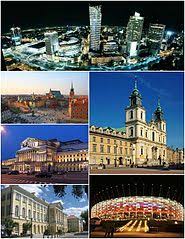Warsaw zawdzięcza swą nazwę rycerzowi z rodu Rawów (Rawicz) named Warsz, to the owner of Warszowa village existing from the 12th / 13th century in the area of today's Mariensztat. When, at the end of the thirteenth century, rich merchants, brought from Toruń, established a princely stronghold here, it was given a name “Warszow”, which was replaced by the modern form only in the 17th century “Warsaw”.

The first credible mention of Warsaw jako ośrodku książęcym pochodzi z roku śmierci księcia Bolesława II (1313 year), merited in the unification of the Duchy of Mazovia. The city was founded on a raw root and had an almost regular geometric layout, which was based on three parallel streets running in the north-south direction (current: Piwna, Midsummer – Nowomiejska, Jesuit – Krzywe Koło) and blocks (Nowadays: Piekarska – Celna, Wąski Dunaj). Around the main square and the market square (now Dunaj Street) plots of various depths were located. Pierwotna zabudowa Starego Miasta (XIV century) it was wooden (together with the first city church of St.. Jana, mentioned in 1316 year). The town was surrounded by a clay-sand embankment with a moat, gradually replaced by a defensive wall with gates.
From the turn of the 14th / 15th century wieku Warszawa stała się miastem rezydencjonalnym księcia Janusza Starszego (patch 1374-1429): the extended castle was the center of administration and culture, a brick princely house, so-called. The Greater Manor (Major Curia), the seed of the future residence of the king. Before the end of the 14th century, the city received Chełmno law, had a city council, an elected local government with a mayor, municipal judicial authority (so-called. bench), a siedzibą władz był ratusz na Rynku. The city covered an area of over 8,5 hectare and was surrounded by walls long 1200 meters. The first brick churches were built: st. Jana i augustianów św. Martin. Po nieparzystej stronie Wąskiego Dunaju, między obecną ulicą Piwną i murami, an autonomous Jewish community was established.
In the early XV The New Town was established in the areas excluded from the jurisdiction of the mayor of Old Warsaw, laid out along the Zakroczymska road, o drewnianej zabudowie i murowanym kościele parafialnym NMP (approximately 1409 year). Buildings from the fifteenth century drewnianą Starego Miasta stopniowo wypierały domy murowane: under Bolesław IV, it was forbidden to build wooden houses in the Market Square. W tym okresie wykształciła się Warsaw bourgeois tenement house: positioned at the peak, with a façade topped with a triangular or stepped gable, with outbuildings at the rear, connected to the main house by a wooden porch. W mid XV – early sixteenth century powstał zewnętrzny pierścień murów (to the Southwest, west and north) with 12 or 13 semicircular towers, with a dry moat and front gates. The last element of medieval buildings was the construction of the 1548 roku Barbakanu przed Bramą Nowomiejską.
